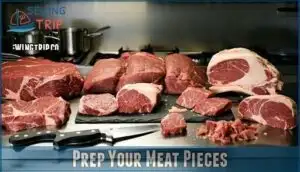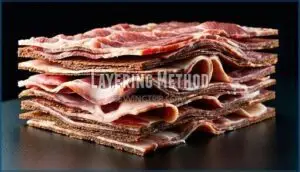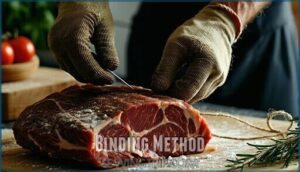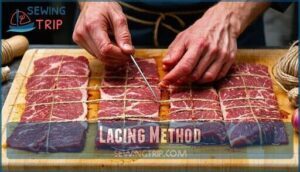This site is supported by our readers. We may earn a commission, at no cost to you, if you purchase through links.
 You’ll sew meat together by securing different cuts with kitchen twine, toothpicks, or butcher’s netting to create unified pieces that cook evenly.
You’ll sew meat together by securing different cuts with kitchen twine, toothpicks, or butcher’s netting to create unified pieces that cook evenly.
This technique works perfectly for stuffed roasts, roulades, or binding ground meat mixtures – just wrap your twine around the meat at regular intervals, pull tight, and tie secure knots.
The process prevents fillings from escaping while ensuring consistent cooking throughout.
Whether you’re creating an impressive beef wellington or simply want to stuff a pork tenderloin with herbs, proper meat sewing transforms ordinary cuts into restaurant-quality presentations that’ll have your dinner guests wondering about your secret techniques.
Table Of Contents
Key Takeaways
- You’ll need to select complementary cuts – choose whole muscle cuts like chuck roast for structure or ground meat varieties that bind well together for your sewing project.
- Proper preparation ensures success – trim excess fat strategically and cut meat into uniform portions so everything cooks evenly when sewn together.
- Master basic binding techniques – use butcher’s twine with simple stitches spaced 1-2 cm apart, or try creative lacing patterns for visual appeal.
- Choose appropriate cooking methods – braise sewn meat for tender results or grill for smoky char, adjusting technique based on your meat construction.
Select Your Meat Cuts
You’ll want to choose meat cuts that bind well together and complement each other’s flavors and textures.
Start with either whole muscle cuts like chuck roast or ribeye, or use ground meat varieties that’ll mesh seamlessly when sewn.
Whole Muscle Cuts
When selecting whole muscle cuts for meat trussing and protein construction, you’ll discover that these large, intact muscle sections offer the perfect foundation for advanced sewing techniques.
Chuck roast, brisket, and pork shoulder provide excellent muscle binding opportunities because their dense fibers hold together beautifully during culinary stitching.
These cuts respond exceptionally well to trussing tools, allowing you to create stunning meat artistry through strategic meat shaping.
Unlike ground alternatives, whole muscle cuts maintain their structural integrity, making them ideal for innovative sewing techniques that transform ordinary proteins into extraordinary culinary creations.
The use of precise cutting tools is essential for achieving professional results in various crafting projects, which is crucial for advanced sewing techniques.
Ground Meat
While whole cuts excel at showcasing natural textures, ground meat opens up entirely different meat sewing techniques through meat manipulation and creative blending.
You’ll discover that ground chuck or sirloin provides ideal fat content for successful meat emulsions, while combinations like Italian sausage with fennel create complex flavor profiles.
When mixing ground varieties, handle gently to maintain texture control – overmixing creates dense, rubbery results.
Try sewing together ground beef, pork, and turkey for innovative hybrid creations that’ll surprise your taste buds.
Natural binding agents in ground meat make it perfect for meat creation projects like custom meatloaf weaves or hand-rolled combinations using leftover stew scraps.
Prep Your Meat Pieces
Before sewing meat together, you’ll need to prepare your pieces properly for the best results.
Start by trimming excess fat using a sharp knife, then cut your meat into uniform portions for even cooking, which involves complete concepts like these to ensure the meat is prepared correctly.
Trim Excess Fat
Once you’ve selected your meat cuts, it’s time for some strategic fat removal. Think of trimming fat like editing a rough draft—you’re keeping the good stuff while cutting the excess.
Use a sharp knife to tackle meat trimming with precision:
- Remove large pockets of external fat that won’t render properly
- Cut away thin webs of fat between muscles for cleaner assembly
- Slice off fatty edges that look unappetizing or won’t cook evenly
- Leave some fat for flavor and moisture—don’t go overboard with excess cutting
Smart fat distribution means keeping marbling while removing chunks that’ll just get chewy. Your lean cuts will thank you later. Effective meat trimming requires using proper meat trimming tools to achieve the best results, ensuring proper trimming for a better culinary experience with cleaner assembly and flavor.
Cut Into Portions
After trimming fat, cut your meat into uniform portions for superior cooking results.
Precision cutting guarantees every piece cooks evenly, preventing some chunks from turning tough while others stay tender.
Use a sharp knife to create consistent 2-inch cubes, maintaining steady pressure throughout each slice.
Uniform cuts aren’t just about looks—they’re your secret weapon for professional-quality results.
When portioning meat, think like a chess master: every move matters.
Each cube should mirror its neighbors in size, creating a harmonious cooking experience.
Your cutting technique directly impacts the final dish.
Practice makes perfect, so don’t worry if your first attempts look like abstract art.
Focus on developing muscle memory for consistent knife work.
Proper meat slicing takes patience, but you’ll master these uniform cubes with repetition and attention to detail, leading to professional-quality results.
Assemble Your Meat Fabric
Now you’ll arrange your prepared meat pieces to create a cohesive "fabric" that will cook evenly together.
You can use either a layering approach for simple combinations or a mosaic method for more complex visual patterns.
Layering Method
Think of meat folding like creating an edible quilt—each layer tells its own delicious story.
The layering method transforms individual cuts into a cohesive meat sculpture through strategic stacking and interlocking technique.
- Alternate muscle and fat layers for enhanced moisture retention and rich flavor combinations throughout your culinary creation
**Alternate textures for ideal mouthfeel.
**The interplay of tender and crispy keeps each bite interesting.
**Vary color placement to delight the eyes.
**A mosaic of pink, red, and brown makes for a visually appealing dish.
**Experiment with meat grain orientation.
**Angling the muscle fibers in different directions adds structural integrity and diverse chewing resistance.
By applying the principles of spice layering techniques, you can create complex flavors in your meat dishes.
This layered cuts approach to food design transforms ordinary ingredients into extraordinary culinary arts.
Your meat reconstruction project becomes both functional and beautiful, creating visual appeal that’ll have dinner guests wondering about your secret technique.
Mosaic Method
Picture yourself crafting edible art through the mosaic method, where meat patterns become your creative canvas.
You’ll interlock contrasting textures and flavors—think marbled beef with pale chicken or ruby-red lamb with golden pork.
This meat reconstruction technique draws textile inspiration from quilting, creating stunning visual presentation through strategic placement.
Unlike the layering method, you’re building geometric shapes or artistic designs that’ll wow dinner guests.
Your interlocking techniques transform ordinary cuts into extraordinary food design masterpieces that taste as impressive as they look.
The mosaic meat cutter technique relies on precise meat cutting tools to achieve the desired patterns and shapes.
Sew Your Meat Together
Now you’ll secure your meat layers using proven butcher’s techniques that guarantee everything stays put during cooking.
Choose between binding with butcher’s twine for traditional results or lacing for creative patterns that add visual appeal.
Binding Method
Once you’ve arranged your meat layers, the binding method using butcher’s twine secures everything perfectly. Thread your needle with food-grade twine and create tight, even stitches along the meat edges. Pull each stitch snug but don’t over-tighten—you’ll tear the muscle fibers.
This trussing technique guarantees your creation holds together during cooking. The quality of butcher twine products is vital for a successful binding method.
- Use overhand stitches for stuffed rolls and roulades
- Space stitches 1-2 cm apart for ideal binding
- Choose 2-3mm thick twine for secure meat joining
- Boil thread 5 minutes before use for food safety
Lacing Method
Anyone can master meat lacing with practice and patience.
Start by puncturing evenly spaced holes through aligned meat strips, then thread butcher’s twine using your preferred sewing patterns.
Try diamond lacing for elegance, zigzag lacing for rustic charm, or swirl lacing for artistic flair.
These trussing techniques transform ordinary cuts into stunning meat weaving masterpieces that’ll impress any dinner guest.
Mastering hand sewing techniques is essential for achieving professional-looking results in various sewing applications.
Cook Your Sewn Meat
Now that you’ve sewn your meat together, it’s time to transform those bound pieces into something truly delicious.
Choose between braising for fall-apart tenderness or grilling for a crispy, caramelized exterior that’ll make your taste buds dance.
Braising
Once your meat pieces are securely sewn together, braising transforms tough cuts into tender, flavorful masterpieces. This slow cooking technique excels at meat tenderization, breaking down connective tissue through gentle, moist heat.
Start by browning your sewn creation in a heavy pot—this develops rich flavors through the Maillard reaction. Add braising liquid like stock or wine until it covers two-thirds of the meat, maintaining moisture retention throughout the process.
Cover and simmer at 300°F for 2-4 hours, allowing collagen to convert into silky gelatin. Your foodgrade stitching will hold everything together while braising techniques work their magic, delivering fork-tender results that showcase true culinary innovation in meat sewing.
Understanding seam allowance techniques can also improve the overall durability of your sewn meat creations.
Grilling
While braising tenderizes your sewn meat beautifully, grilling delivers that irresistible smoky char we all crave.
Fire up your grill and master these grilling essentials:
- Monitor grill temperatures – maintain medium-high heat (400-450°F) for proper searing techniques
- Practice meat rotation – flip once halfway through for even char formation
- Control smoke levels – adjust vents to prevent bitter flavors from overwhelming your creation
Choose thicker cuts like ribeyes for superior results, and let meat reach room temperature first.
This backyard grilling approach transforms your sewn masterpiece into a caramelized triumph of kitchen skills and cooking techniques.
Frequently Asked Questions (FAQs)
How do I make my own stew meat?
You’ll need a sharp knife and chuck roast or bottom round. Cut the tough beef into uniform 2-inch cubes, trimming excess fat but leaving some for flavor and moisture.
How to cook meat the easy way?
Start with lean cuts like chicken thighs or pork shoulder.
Season generously, then use one-pot methods like braising or slow cooking.
These techniques break down tough fibers automatically, creating tender, flavorful results with minimal effort required.
Do you have to sear a beef stew?
Research shows 75% of home cooks skip searing, but you don’t have to sear beef stew.
While searing creates flavorful browning that enhances taste, it’s not essential for tender results.
Your stew will still turn out delicious without this step.
How do I choose the best meat for beef stew?
Choose chuck roast, shoulder roast, or bottom round for their marbling and tough connective tissue that breaks down beautifully during slow cooking, creating tender, flavorful stew meat.
How do you make stew meat tender?
Think tough stew meat’s your enemy? You’ll conquer it with low, slow cooking that breaks down connective tissue, transforming chewy chunks into fork-tender bites through patient simmering.
How do you thicken a beef stew?
Low and slow cooking naturally thickens beef stew as connective tissue breaks down into gelatin. You can also add flour-coated meat, cornstarch slurry, or tomato paste for extra thickness.
What are the steps to making a stew?
Transform humble ingredients into culinary gold by browning your meat first, then building layers of flavor.
Sauté aromatics, add liquid, and let time work its magic through gentle simmering until everything melts together beautifully, creating a dish that is truly culinary gold.
Can I use regular twine for meat?
No, don’t use regular twine for meat. You’ll need butcher’s twine specifically—it’s heat-resistant, uncoated, and food-safe. Regular craft twine contains chemicals and dyes that’ll contaminate your food.
How to make a meat step by step?
Creating meat step-by-step begins with proper preparation.
First, select quality cuts like chuck roast, trim excess fat, and cut into uniform pieces.
Season generously, sear for color, then slow-cook with aromatics until tender.
Reorganizing the text improves its clarity and readability.
What types of needles work best for meat?
Large, heavy-duty needles work best for sewing meat together.
You’ll need stainless steel varieties or butcher’s needles that can pierce tough skin and muscle.
Choose ones with curved designs for easier maneuvering around natural contours during preparation.
Conclusion
Beyond restaurant kitchens where chefs painstakingly craft perfect presentations, your home kitchen transforms into a culinary workshop when you learn how to sew meat properly.
You’ve mastered binding techniques that prevent fillings from escaping while ensuring even cooking throughout every bite.
Your stuffed roasts, roulades, and ground meat creations now rival professional establishments, creating impressive dishes that showcase your newfound skills and deliver consistently tender, flavorful results every time.
With practice, you’ll confidently tackle any recipe requiring sewn meat.
- https://pmc.ncbi.nlm.nih.gov/articles/PMC9039213/
- https://www.reddit.com/r/LifeProTips/comments/1hbv9q3/lpt_food_having_that_restaurant_quality_requires/
- https://btleighs.com/blogs/lets-talk-about/why-layering-your-bbq-spices-beats-mixing-them-all-together
- http://www.welike2cook.com/2011/11/tow-trussing.html
- https://www.nm.org/healthbeat/healthy-tips/make-meat-safety-a-household-priority












